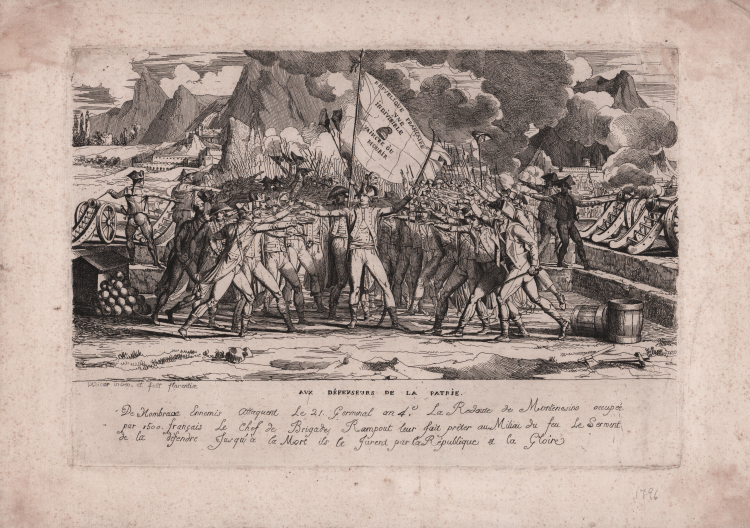



| Reference: | S44831 |
| Author | Jean-Baptiste Joseph WICAR |
| Year: | 1796 ca. |
| Measures: | 300 x 210 mm |


| Reference: | S44831 |
| Author | Jean-Baptiste Joseph WICAR |
| Year: | 1796 ca. |
| Measures: | 300 x 210 mm |
Aux défenseurs de la patrie: De Nombreux Ennemis Attaquent Le 21 Germinal an 4.e. La Redoute de Montenesino [i.e Monteligino] occupée par 1500 français Le Chef de Brigade Rampout [sic] leur fait prêter au Milieu du feu le Serment de la défendre Jusqu'à la Mort ils le Jurent par la République et la Gloire.
Etching, signed at lower left Wicar inven. et fecit Florentiae.
The print shows Colonel Rampon and the men of his battalion taking the oath to fight to the death the Austrians in defense of Montenotte, April 1796.
A fine impression of this very rare work, printed on contemporary laid, some foxing and waterstains in the margin, otherwise good condition.
Jean-Baptiste Wicar (22 January 1762 – 27 February 1834) was a French Neoclassical painter and art collector. He studied drawing at the free school in Lille before further honing his talents in the studio of David. He finally permanently settled in Rome in 1800 and became a portraitist of European renown. On his death in Rome in 1834, Wicar left the major collection of 1,300 drawings he had accumulated over his lifetime to the Société des Sciences, de l’Agriculture et des Arts de Lille.
https://gallica.bnf.fr/ark:/12148/btv1b69535019.item
Bibliografia
De Vinck, 6852; Hennin, 12200.
Jean-Baptiste Joseph WICAR (Lilla, 22 gennaio 1762 – Roma, 27 febbraio 1834)
|
Jean-Baptiste Wicar (22 January 1762 – 27 February 1834) was a French Neoclassical painter and art collector. The son of a carpenter, Wicar was born in Lille. He studied drawing at the free school in Lille before further honing his talents in the studio of David. The drawings Wicar created of Tableaux, statues, bas-reliefs et camées de la Galerie de Florence et du palais Pitti (Paintings, statues, bas-reliefs and cameos in the Gallery of Florence and the Pitti Palace) were published in Paris in 4 volumes at the Lacombe publishing house from 1789 to 1807. Wicar headed the commission set up to loot artworks from the Austrian Netherlands to enrich museums in France. An initial convoy left Antwerp on 11 August 1794, notably with paintings by Rubens, for the Louvre. Abbeys and castles were systematically emptied of their contents, furniture and works of art. Wicar was also a member of the commission des sciences et des arts on the Italian campaign, in the entourage of Bonaparte. This commission was charged with seizing artworks that could enrich French national museum collections. He finally permanently settled in Rome in 1800 and became a portraitist of European renown. On his death in Rome in 1834, Wicar left the major collection of 1,300 drawings he had accumulated over his lifetime to the Société des Sciences, de l’Agriculture et des Arts de Lille. Mostly from the Italian school, but also in some small measure from the northern schools, it held drawings by artists like Raphael, Albrecht Dürer, Lucas Cranach, Nicolas Poussin and Jacques-Louis David. This legacy initially formed the public "musée Wicar", which in 1866, merged into the Palais des beaux-arts de Lille.
|
Jean-Baptiste Joseph WICAR (Lilla, 22 gennaio 1762 – Roma, 27 febbraio 1834)
|
Jean-Baptiste Wicar (22 January 1762 – 27 February 1834) was a French Neoclassical painter and art collector. The son of a carpenter, Wicar was born in Lille. He studied drawing at the free school in Lille before further honing his talents in the studio of David. The drawings Wicar created of Tableaux, statues, bas-reliefs et camées de la Galerie de Florence et du palais Pitti (Paintings, statues, bas-reliefs and cameos in the Gallery of Florence and the Pitti Palace) were published in Paris in 4 volumes at the Lacombe publishing house from 1789 to 1807. Wicar headed the commission set up to loot artworks from the Austrian Netherlands to enrich museums in France. An initial convoy left Antwerp on 11 August 1794, notably with paintings by Rubens, for the Louvre. Abbeys and castles were systematically emptied of their contents, furniture and works of art. Wicar was also a member of the commission des sciences et des arts on the Italian campaign, in the entourage of Bonaparte. This commission was charged with seizing artworks that could enrich French national museum collections. He finally permanently settled in Rome in 1800 and became a portraitist of European renown. On his death in Rome in 1834, Wicar left the major collection of 1,300 drawings he had accumulated over his lifetime to the Société des Sciences, de l’Agriculture et des Arts de Lille. Mostly from the Italian school, but also in some small measure from the northern schools, it held drawings by artists like Raphael, Albrecht Dürer, Lucas Cranach, Nicolas Poussin and Jacques-Louis David. This legacy initially formed the public "musée Wicar", which in 1866, merged into the Palais des beaux-arts de Lille.
|